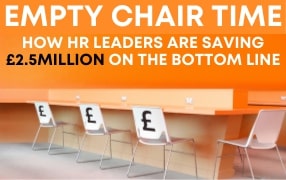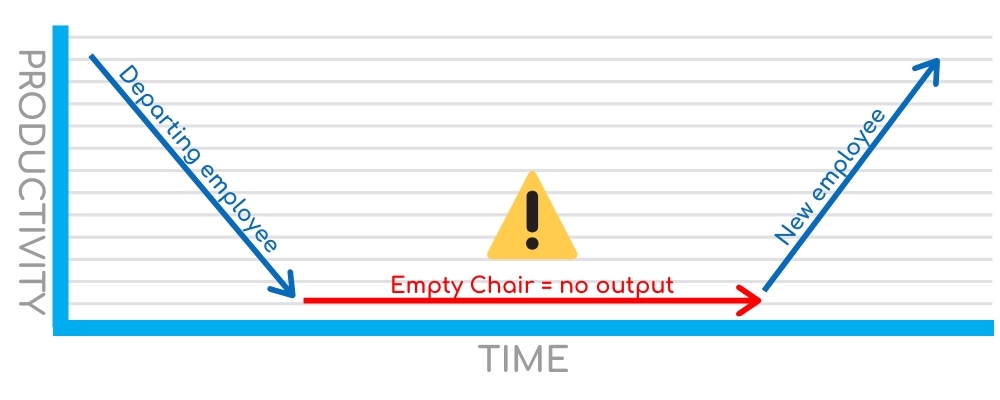
Empty Chair Time
Empty Chair Time
February 07, 2023
The tired old metrics you live your life by as a HR professional are meaningless to your business. It’s time to start talking about Empty Chair Time and Cost; read on to learn more…
How HR Leaders are saving £2.5 MILLION on the bottom line
DID YOU KNOW: It costs on average £909 per day for every empty sales vacancy in an organisation?
*for an organisation with revenue of £1bn, employing 5000 employees
That’s £31,815 per vacancy.
Still doesn’t sound a lot until you multiply that for all your yearly vacancies... for a large organisation making 900 hires, it quickly adds up to £28,633,500.
We still haven’t factored getting your new employee up to full productivity, but having nearly £30 million a year in lost revenue is surely enough to make any Exec worth their salt sit up and take notice?

Had you ever thought about how empty seats impact productivity due to inefficiencies within HR?
What would your CEO say if one of your peers - such as the Finance, Supply Chain or Sales Director - took an opportunity to put just half of £28,633,500 back on the bottom line? They’d have the CEO’s attention on day 1, investment to make it happen on day 2, and it would be a company-wide initiative by day 3 (well, perhaps a bit slower...). It’s time for the HRD to step up and take their opportunity!
You might even be thinking,
"I’d take 10% of that improvement"
So as an HR leader, you should be driven to make better business decisions with data. You should use this data to create strategic objectives for your team.
THE FIRST QUESTION IS:
...do you have the data at your fingertips to start impacting this huge opportunity of empty seat / lost productivity within your business?
A quick way to find out if you have the data is to ask for the following from your team members:
An accurate report of every potential performance risk, by business area
An accurate report of every potential flight risk, by business area
An accurate report of future talent demand, by business area
What would your Head of HRBP’s / TA’s response be if you asked for this? Silence? Panic? Bewilderment? Embarrassment?
You may never have thought of these ‘future’ data sources before; but they are the holy grail of proactive HR delivery.
If your teams don’t have access to this data, then how can they be providing a proactive & strategic service?
These three buckets of data are your greatest chance to make a huge impact on your companies’ productivity from an HR perspective. And, dare I say it, your ability to show your value onto the bottom line.
So back to that elusive ‘Empty Chair Time’. What would be the impact on you and your organisation?
If you could shave one day off the Empty Chair Time of 35 days, it would save your business £818,100. Talk about marginal gains!
How about we explain where the inefficiencies are & how they’re fixed?
We’ll give you three examples. Do one, and you’ll save £818,100.
Do all three, you’ll save £2,454,300.
1. PERFORMANCE MANAGEMENT DELAYS
A manager has an underperforming team member. They’ve been underperforming for 6 months. The manager is becoming more and more frustrated. Eventually, breaking point happens, and the manager picks up the phone to their HRBP and explains they’d like to exit the underperformer. The HRBP asks to see the performance plan the manager has executed.
Silence.
They haven’t done anything. The manager didn’t know it was "their job" to do so. Now the HRBP has 2 options. Carry out a costly compromise agreement/exit process, or guide the manager into carrying out a 3-6-month performance plan (usually against their wishes). If you exit the person, you are going to start accruing Empty Chair Time immediately. The clock has already started ticking.
If you put them on a performance plan, then productivity is already lower than it should have been - and perhaps you could be delaying the inevitable. Tick, tock...
What is the root cause of the issue?
The issue is the amount of time the manager sat on the information about the performance issue before instigating the action (and because the HRBP didn’t have the report of every future performance issue, they couldn’t intervene). At this moment it’s almost irrelevant that the manager didn’t know the correct course of action. If we can get better at understanding the signals earlier, we can ensure the education of the appropriate action.
So how do I shave off one day?
Simple. If your HRBP’s had a dedicated conversation with every single manager in the business areas they support, every month, then they’d flush out all this information after just one month, not six. (You’d also be shaving off more than one day.)
"But my HRBP’s can’t possibly have a dedicated conversation with each manager. We’ve got 1000 managers! That would be 1000 managers x 30 minute meeting = 500 hours/month, on top of their current workload."
Technically you’d need 31 weeks to have that many conversations. And 16 full-time employees to execute it. That’s why it’s not executed.
But what if...
there was something that could have these conversations on my HR team’s behalf, to free up their time? Now you’re getting into the top 5% of HRDs way of thinking.
It is possible, and it’s easier than you might think. Stick with it whilst we explore the other savings as the same solution solves all 3 in one go (and I don’t want to ruin the surprise).
2. FLIGHT RISKS
Imagine how powerful it would be to understand all the flight risks in your business. Think of the proactive initiatives we could put in place to retain & redeploy our top talent.
We spend huge amounts of money trying to attract quality, diverse talent. But just as we’re filling up the organisation with it, it’s leaking out the other side of the talent funnel. It’s about as inefficient as trying to bail water out of a sinking ship with nothing but a teacup.
For our HR function to have maximum impact, we need to address both ends of the talent spectrum. People become flight risks because they’re disengaged. Why are they disengaged? Endless reasons, but in the main:
- They aren’t challenged enough in their role
- They don’t feel fairly remunerated
- They feel ready for another role
Who in our business is closest to our talent? Our managers. They’ll have their finger on the pulse of their team. They’ll know who feels undervalued and ready to move on. Yes, they’ll get things wrong, but remember at this point we’re only looking for an Empty Chair Time saving of one day.
So how do we extract this info from our manager’s heads? Simple. Ask them.
"But my HRBP’s can’t possibly have a dedicated conversation with each manager. We’ve got 1000 managers! That would be 1000 managers x 30 mins = 500 hours/month, on top of their current workload."
Starting to see a correlation between the reason we are not getting the data we need to make a massive impact?
If your HRBP’s had a central source of flight risk data to focus their efforts on and you retained 26 leavers per year, you would save another £818,100 in lost productivity (26 leavers equates to ~900 empty chair days).
So far by accessing the data of all performance and flight risk profiles within your business, you’ve saved £1,636,200.
The first two points are preventative measures to try and stop as many costly recruiting exercises as we can. The next one is where it has resulted in recruitment demand...
3. SLOW COMMUNICATION
There is a huge time lag in the recruiting process between a person leaving, a new project starting, and the recruitment team starting the recruitment process. This is because the average hiring manager only informs your Recruitment team 30 days before the person leaves, regardless of how long they have known about it. So if the future employee is on a 30 day notice period, then your recruiters must make a hire on the same day for there to be no Empty Chair Time. Not possible!
In reality, recruitment teams will take 30, 60, sometimes 90 days to fill these roles after the person has already left. You can now see a clear dip in productivity, and therefore lost revenue.
Doesn’t it seem obvious that the recruitment team should try and minimise this gap in business intel?
IN SIMPLE MATHS, THIS IS WHY IT’S NOT HAPPENING:
If your average recruiter has 25 live vacancies, that’s around an hour and a half per week per vacancy to brief, advertise, source, attract, interview, engage, offer plus a hundred other admin activities. Now your recruitment leader is going to ask them to spend more time with each potential manager to understand their future demand too? I don’t think so. This is why it gets dropped, quick sharp. How dangerous is it that the recruiter gets to decide this?
This is one of the root causes of that £28,633,500 going out the window.
You might expect the recruitment leader to be all over this. Why aren’t they?
They’re not strategically minded enough for this. It’s a new way of thinking. Obvious, but new.
Recruitment leaders are more focused on trying to reduce their Time to Hire rather than reducing empty seats. If they had more strategic conversations about their hiring goals linking in with the objectives of the business functions they supported, then they would stop thinking tactically about Time to Hire, and more about business delivery.
Ironically, if your recruitment leader thought a bit longer term, then their Time to Hire would increase, because they’d have longer lead times for talent needed within their business. So if your recruitment leader could get just one extra day heads up before the seat became vacant, then there is your extra £818,100 - now totalling £2,454,300.
Not to mention they’ll be able to recruit more diverse and inclusive talent with the extra time they’ve gained.
So there remains one last item. How do you propose to have so many conversations with the business to extract this information en-masse?
Forward-thinking HR Leaders are now intervening with tech to do the heavy lifting to extract this valuable data resource and remove the low-value activity of the meetings and capturing, collating the data. Freeing up the HRBPs and wider recruitment team to make better business decisions and interventions and focus on the more valuable strategic elements of their roles.
The tech element is also improving both employee and manager experience, giving them confidence HR is listening and, in a place, to guide to a positive outcome. Managers engaged regularly are more inclined to share feedback, improvements, flag pressures, etc well ahead of it becoming an issue.